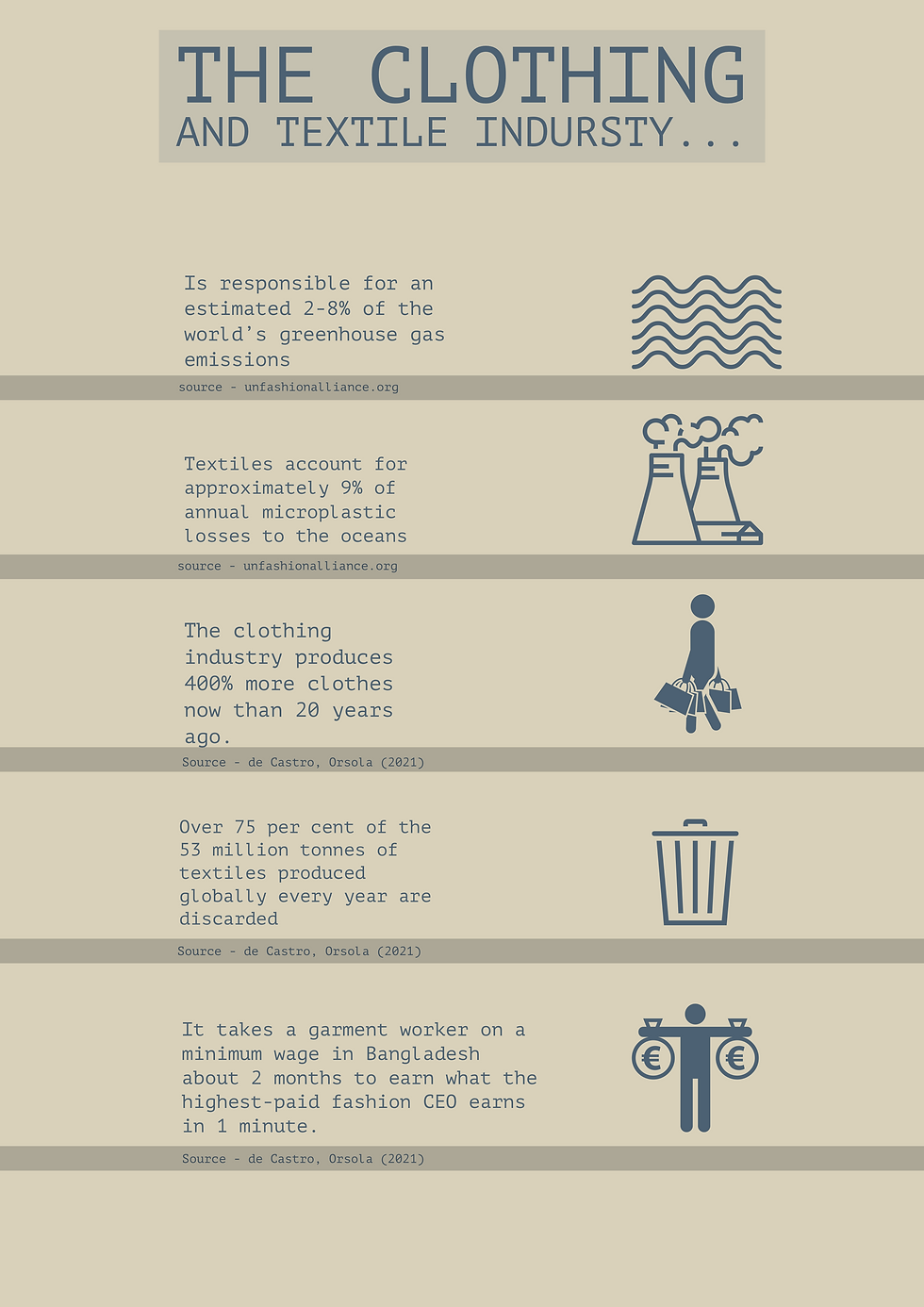What Is Slow Fashion?
- Anja Brachhaus
- Oct 12, 2021
- 3 min read
”There is no better time than right now to push for change, and there is no better place to start than with your wardrobe.” - Orsala de Castro
I’m sure, that everyone reading this, has enough clothes to theoretically dress for the next decades. But why do we constant demand to buy new, even though our closets are jam-full?
Even though we’re all familiar with the term fast fashion, and everyone, in some way, has heard about the dark sides of the fast fashion industry, it is still hard to understand how bad things really are. Therefore, before talking about slow fashion, let’s clarify what fast fashion is.
What is fast fashion?
Earlier the fashion industry used to work like this: Designers introduced new collections at fashion weeks 2-4 times per year. The clothes then appeared in stores, until they slowly, after several month trickled down to the average consumes. Today it will only take around 1-2 weeks, until you can buy fashion week styles in fast fashion stores like Zara and H&M. In short, there are around 52 seasons, almost one every week of the year.
The business model of fast fashion is based on copying designs to speed the production up. The system thrives on selling constantly changing trends in a poor quality at minimum prices, in order to lure customers to constantly buy new. But how can the fast fashion system make these two components of fast production and low prices work? By dropping quality and reducing the production costs to the minimum. In a nutshell, employees of the textile factories are forced to work in unsafe conditions for minimum wages and long working hours. Add to the ethical issue, the fast fashion system conceals major consequences for the environment and is bad for the customers as well. To bring it to the point, here are some facts about the clothing and textile industry, you should know about:

So having outlined what fast fashion is, it should be clear now that we absolutely need to stop seeing our clothes as disposable, we might slow down this harmful cycle of buying endlessly, and oftentimes unnecessarily. That leads us to slow fashion.
What is slow fashion?
Slow fashion stands for the deceleration of the fashion industry and is everything that fast fashion is not. Slow fashion focuses on the importance of quality over quantity. The main goal is to encourage fair labor standards and wages, a slower production schedule including preferably zero clothing waste. Embracing slow fashion means: “ (…) to value knowing where the materials originate and how the garment is made; knowing that laborers are fairly paid and safe from human rights violations; knowing that clothing is of high quality; and knowing that environmentally friendly care and disposal is part of the design.” (Bye, 2020). For us as consumers, slow fashion is about evolving a conscious approach to clothes. It is about appreciating the clothes that you already own, caring about and reducing the environmental effects of our possessions, standing up against a throw-away culture, overconsumption and being allured to buy clothes we don’t really need.

Besides slow fashion, you might certainly have come across terms such as sustainable-, ethical- and fair-trade fashion. Let’s briefly clarify what these terms mean:

Welcome to ReLove
Here at ReLove we hope to inspire you to form new habits in caring and loving your clothes. Today we are so used to replacing our clothes instead of repairing them. Therefore, we made a conscious decision not to talk about how and where to buy sustainable fashion, we decided not to talk about buying new at all. It is all about re-loving the clothes you own; show them the respect they deserve and care for each item.
Let’s discover the joy and satisfaction of spending time with our clothes. ReLove is about being creative, thinking and acting. Our mission is to motivate you, and at the same time to challenge ourselves, to recreate a relationship with our clothes, to rethink what is convenient and, of course, slow fashion down. We will talk about maintaining, repairing, upcycling, creativity, exploring new clothing combinations and whatever comes to our mind.
“Small actions undertaken by individuals, if multiplied by millions, can become a powerful tool for action.” Orsala de Castro
So, today is a good day to cut down on fast fashion, right?
Bibliography
Bye, E. (2020). Sustainability Must Drive Design . I The Dangers of Fashion: Towards Ethical and Sustainable Solutions(s. 19-34). London : Bloomsbury Visual Arts.
de Castro , O. (2021). I Loved Clothes Last . Penguin Random House UK.
Stanton , A. (2021). What Is Fast Fashion, Anyway? Hentet fra The Good Trade : https://www.thegoodtrade.com/features/what-is-fast-fashion
The Well Co. . (2018). Hentet fra thewellessentials.com : https://www.thewellessentials.com/blog/how-i-created-a-sustainable-wardrobe-made-3000-in-the-process
UN Alliance For Sustainable Fashion . (u.d.). Hentet fra unfashionalliance.org : https://unfashionalliance.org/


Comments